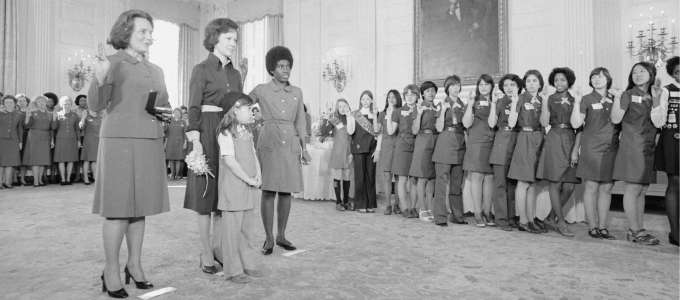First Lady Rosalynn Carter hosts the Girl Scouts at the White House. (Photo courtesy of the White House)
Peter Drucker once publicly stated that Frances Hesselbein was the greatest leader he had ever met.
I agree, though I am biased because she is one of my best friends. We have edited seven books together and volunteered on projects in many different countries. In 1998, she invited me to the White House when President Bill Clinton awarded her the Presidential Medal of Freedom, the highest honor for a civilian in the United States, in recognition of her outstanding leadership.
Frances was the national executive director and CEO of the Girl Scouts of the USA from 1976-1990. She entered the organization during a tough period. Membership was declining, finances were poor, and the organization did not represent the demographics for girls in America.
How could she create a positive, vibrant, new organization that represented the future, without putting down the past? She came up with a simple phrase that perfectly captured her vision: “Tradition with a future.”
Frances committed to changing the organization while simultaneously honoring its past. An early test involved the Girl Scout uniforms. She recruited fashion designer Bill Blass to design a striking, more modern uniform, but many Girl Scout leaders had saved their old uniforms and were very proud of them. Frances wisely decided the Scouts could choose to wear either.
In her efforts to transform the Girl Scouts, Frances spent as much time on what to preserve as she did on what to create. In my work as an executive coach, I often encourage my CEO clients to learn from her.
There is a great danger that new CEOs, especially those brought in from outside the organization, will become so focused on creating a new company that they appear to demean the previous organization and its employees. It’s important to focus on what we need to create in the future, but it can be just as important to choose what to preserve from the past.
Think of your own efforts to become the person you want to be. Along with describing the new you, always remember to appreciate the elements of the old you that you want to honor and respect.
For many years now, I’ve been using “The Wheel of Change” to help clients decide what to change, what not to change, and where to put their efforts. The Wheel of Change illustrates the interchange of two dimensions we need to sort out before we can become who we want to be.
The positive to negative axis tracks elements that help us or hold us back. The change to keep axis tracks the elements we determine to change or keep in the future. Thus, we the option to change or keep the positive, or change or keep the negative.
1. Creating represents the positive elements we want to create in our future. When we imagine ourselves behaving better, we think of it as an exciting process of self-invention, creating a “new me.” We can be anyone we choose to be. The challenge is to do it by choice. Are we creating ourselves or wasting the opportunity and being created by external forces instead?
2. Preserving represents the positive elements we want to keep in the future. It requires soul-searching to figure out what serves us well, and discipline to refrain from abandoning that for something new and shiny and not necessarily better.
3. Eliminating represents the negative elements we want to discard. Eliminating is our most liberating, therapeutic action, but we make it reluctantly. We never know if we’ll regret jettisoning a part of us.
4. Accepting represents the negative elements we need to accept. Most of us tend to commit to the other three elements in the wheel of change with greater enthusiasm, but acceptance is an odd player in the change process. It feels like admitting defeat, or acquiescence. This truth can trigger our finest moments of counterproductive behavior.
Some of these choices are more dynamic, glamorous and fun than others, but they’re equally important. When we bluntly challenge ourselves to figure out what we can change and what we can’t, what we want to lose and what we want to keep, we often surprise ourselves with the bold simplicity of our answers and can thus take significant, real steps toward becoming who we really want to be.
















